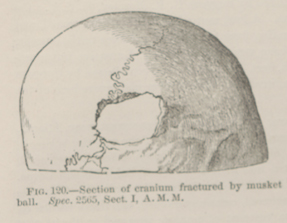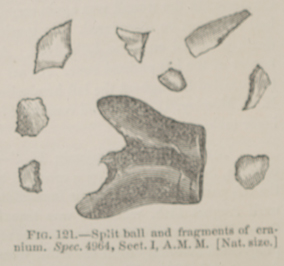Title: S——, Edward
Source text: Surgeon General Joseph K. Barnes, United States Army, The Medical and Surgical History of the War of the Rebellion. (1861–65.), Part 1, Volume 2 (Washington, D.C.: Government Printing Office, 1870), 253.
Civil War Washington ID: med.d1e16400
TEI/XML: med.d1e16400.xml
CASE.—Private Edward S——, Co. L, 11th Vermont Volunteers, aged 18 years, was wounded at the battle of Cold Harbor, Virginia, June 3d, 1864, by a conoidal ball, which fractured the occipital bone, just above the left extremity of the superior curved line. He was conveyed to Washington, and on the 10th, admitted into Emory Hospital. On the 11th, Surgeon N. R. Moseley, U. S. V., extracted the ball from the left lateral sinus, removed spiculæ of bone, and elevated the depressed portions. Well marked symptoms of compression of the brain existed, with great mental derangement, and the patient was comatose most of the time. Sponges were introduced into the wound to control hæmorrhage, and cold water dressings were applied. A temporary improvement took place, but death ensued on June 18th, 1864. The pathological specimens are shown in the wood-cuts. The opening in the occipital bone, from which fragments have been removed, measures one and a half inches horizontally and one inch in width; the posterior part of the edge shows marks of having been cut away by the bone gouge forceps. There is no fissuring. The surrounding portions of the inner table show marks of diseased action. The specimen was contributed by Surgeon N. R. Moseley, U. S. V.

